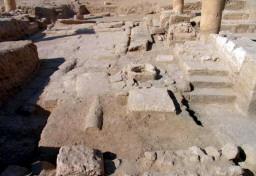An Italian-led team of experts has uncovered a vast, ancient necropolis near the Syrian oasis of Palmyra.
The team, headed by Daniele Morandi Bonacossi of Udine University, believes the burial site dates from the second half of the third millennium BC.
The necropolis comprises around least 30 large burial mounds near Palmyra, some 200km northeast of Damascus.
''This is the first evidence that an area of semi-desert outside the oasis was occupied during the early Bronze Age,'' said Morandi Bonacossi.
''Future excavations of the burial mounds will undoubtedly reveal information of crucial importance''.
The team of archaeologists, topographers, physical anthropologists and geophysicists also discovered a stretch of an old Roman road.
This once linked Palmyra with western Syria and was marked with at least 11 milestones along the way. The stones all bear Latin inscriptions with the name of the Emperor Aurelius, who quashed a rebellion led by the Palmyran queen Zenobia in AD 272.
The archaeologists also unearthed a Roman staging post, or ''mansio''. The ancient building had been perfectly preserved over the course of the centuries by a heavy layer of desert sand.
The team from Udine University made their discoveries during their tenth annual excavation in central Syria, which wrapped up at the end of November.
The necropolis is the latest in a string of dazzling finds by the team.
Efforts have chiefly focused on the ancient Syrian capital of Qatna, northeast of modern-day Homs.
Since starting work there in 1999, the team has uncovered more than 1,500 square metres of the town's acropolis dating back to the Middle and Late Bronze Age.
Among the highlights of the investigation was the discovery of a sprawling complex, since named the Royal Palace.
Extending the focus east of the royal palace this year, archaeologists uncovered an even larger building.
''This discovery is not just exceptional for the imposing nature of the building itself, comprising at least 25 individual rooms around a large courtyard, but also for the period in which it was built,'' said Morandi Bonacossi.
The building, nicknamed the Eastern Palace, was constructed in around the 19th century BC.
''Until now, there had been no indications that buildings of that size existed in Qatna yet this one appears to have been in use for around 500 years,'' he said.
Qatna, a once powerful trading city, vied with the centres of Aleppo and Mari for geopolitical supremacy over the entire region in the first half of the second millennium BC.
Basalt statues of Syrian kings, intricate inlay work, delicate funerary objects and elaborate lists of grain supplies have all come out of the earth at Qatna since Italian and German archaeologists began digging in the area.









